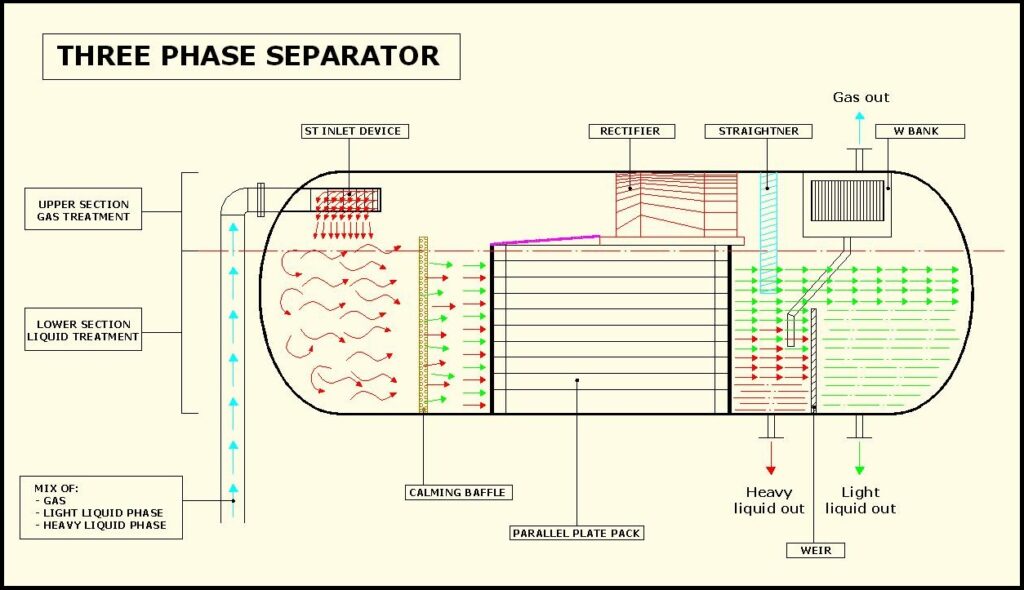Aricle written By : Pallavi Wankhede
Three phase separator is a type of vessel, used to separate oil, gas and water from the fluids which is obtained from the downstream of wellhead. The fluid which is also called as extracted crude oil contains lots of hydrocarbons and dissolved impurities. Before oil can be sold in the industry, it needs to be separated from all these components in crude oil.
It is most commonly used in oil and gas industry. Depending on the configuration, there are generally 3 types of three phase separators: horizontal, vertical and spherical.
Horizontal Three Phase Separator:
Also Read : Heat Exchanger Design
Also Read : What is Pump Head and Shut-off Head ?
Working:
In a horizontal three phase separator, the fluid enters through the inlet and hits an Inlet Diverter. This gives a sudden change in the momentum of fluids and starts to separate liquid and vapor.
The liquid section of the separator must provide sufficient time for oil and emulsion to form a layer above the water.
A weir (the type of plates) maintains the oil level while an interface controller maintains the water level.
The oil spills over the top of the weir and the level controllers which operate the oil dump valve controls its level.
An interface level controller senses the height of the oil-water interface. This controller signals the water dump valve to release as much water as needed to maintain the oil-water interface at design height.
The gas flows horizontally and exits through a mist extractor with the help of a pressure control valve (PSV) which also maintains the constant separator pressure.
Read Also : Difference between Pressure Relief Valve and Pressure Safety Valve
Vertical Three Phase Separator:
Working:
- In a vertical three phase separator, the fluid enters through the side and hits an inlet diverter like a horizontal three phase separator and separates the bulk of the gas.
- A down-comer is used to transmit the liquid through the oil-gas interface and avoid disturbance in the oil skimming action.
- A chimney equalizes the gas pressure between the lower section and gas section.
- The down-comer outlet is located at the oil-water interface. From this point as the oil rises, any free water separates out from the oil phase.
- The water droplets flow in counter-current direction to the oil. Similarly, the water flows downward and oil droplets trapped in the water phase which increases the counter current water flow.
Spherical Three Phase Separator:
Working:
- The working principle for spherical three phase separator is quite similar to horizontal and vertical phase separators.
- It can be used for two or three phase separation process.
- It is most commonly used to separate oil, gas and free water from the fluid.
- It is also called as free-water-knockout.
- On the other hand, it is a very compact vessel.
Selection and Efficiency of Three Phase Separators:
- Selection of a three phase separator type is primarily based on gas handling requirements and space availability.
- A horizontal three phase separator is usually more efficient for the handling of large volume gas. Due to its large interfacial areas, it has better phase separation capability. It does not handle solids.
- A vertical three phase separator is more efficient for solid handling and requires far less place than horizontal separator. It also has much better liquid surge capacity but on the other hand it is very difficult to service.
- A spherical three phase separator is used to remove free water in the fluids. The free water in the fluid can leads to the formation of tight emulsions or hydrates which are difficult to break. By removing free water, it can avoid problems like corrosion and the formation of tight emulsions or hydrates. The free water discharged from the spherical separator can be further treated in vessels like treaters. It has very less space for surge and liquid settling. The performance of liquid level control in a spherical separator is very critical. Thus it is rarely used on large scale.
- Regardless of the type of three phase separator, they have certain internal components in common. Eg. Inlet diverter provides the initial growth separation of fluid by changing the flow direction as fluid enters the vessel. Mist extractors coalesce and collect small liquid drops from separated gas before the gas leaves the vessel.
- In three phase separators, the most frequently occurring operating problems are corrosion, the formation of hydrates, foaming crude, paraffin build-up, sand accumulation, liquid carryover, gas blow-by and formation of emulsions.
- To avoid all these problems, separators need to be designed properly. The designing of separators requires the thorough understanding of the separator operating principles and their relation to variables such as the settling of the oil droplets, retention time and droplet size.
Article Source:
- https://en.wikipedia.org/
- https://www.honiron.com/
- https://www.glossary.oilfield.slb.com/
- http://www.oilfieldwiki.com/
Image Source: Oil and Gas Processing; PETROBLOGGER.COM; AFP Tech

